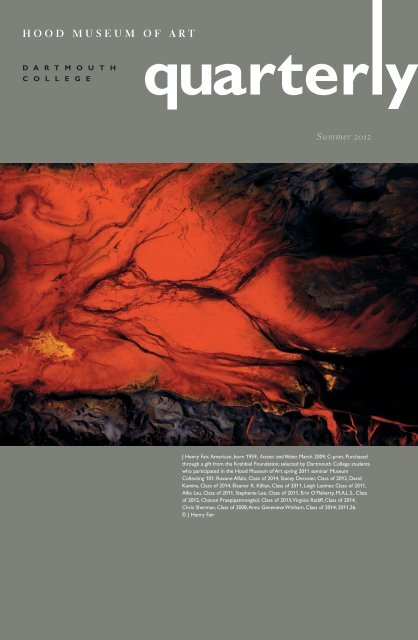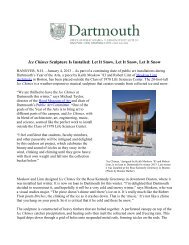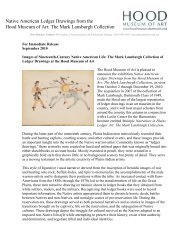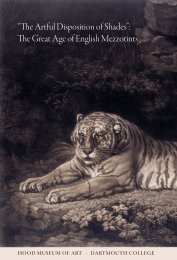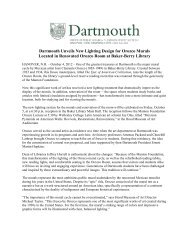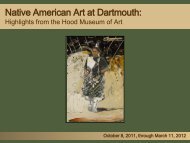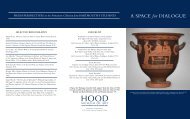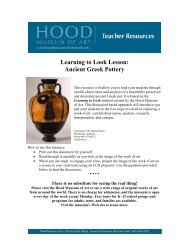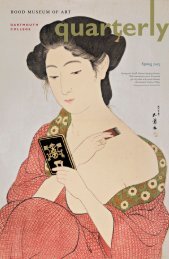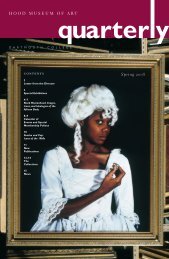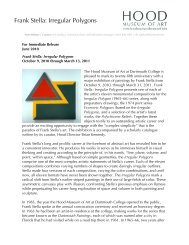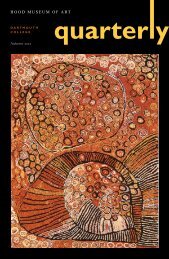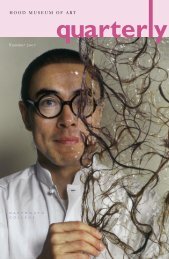Summer 2012 - Hood Museum of Art - Dartmouth College
Summer 2012 - Hood Museum of Art - Dartmouth College
Summer 2012 - Hood Museum of Art - Dartmouth College
You also want an ePaper? Increase the reach of your titles
YUMPU automatically turns print PDFs into web optimized ePapers that Google loves.
HOOD MUSEUM OF ART<br />
quarter y<br />
D A R T M O U T H<br />
C O L L E G E<br />
<strong>Summer</strong> <strong>2012</strong><br />
J Henry Fair, American, born 1959, Arsenic and Water, March 2009, C-print. Purchased<br />
through a gift from the Krehbiel Foundation; selected by <strong>Dartmouth</strong> <strong>College</strong> students<br />
who participated in the <strong>Hood</strong> <strong>Museum</strong> <strong>of</strong> <strong>Art</strong> spring 2011 seminar <strong>Museum</strong><br />
Collecting 101: Roxane Aflalo, Class <strong>of</strong> 2014, Stacey Derosier, Class <strong>of</strong> <strong>2012</strong>, David<br />
Kamins, Class <strong>of</strong> 2014, Eleanor K. Killian, Class <strong>of</strong> 2011, Leigh Latimer, Class <strong>of</strong> 2011,<br />
Allie Lau, Class <strong>of</strong> 2011, Stephenie Lee, Class <strong>of</strong> 2011, Erin O’Flaherty, M.A.L.S., Class<br />
<strong>of</strong> <strong>2012</strong>, Chanon Praepipatmongkol, Class <strong>of</strong> 2013,Virginia Ratliff, Class <strong>of</strong> 2014,<br />
Chris Sherman, Class <strong>of</strong> 2008,Anna Genevieve Winham, Class <strong>of</strong> 2014; 2011.26.<br />
© J Henry Fair
2<br />
LETTER FROM THE DIRECTOR<br />
This summer we have an exciting roster <strong>of</strong> exhibitions that speaks to the primary<br />
mission <strong>of</strong> the <strong>Hood</strong> <strong>Museum</strong> <strong>of</strong> <strong>Art</strong>, which is to teach with original works <strong>of</strong> art.<br />
Every year, thousands <strong>of</strong> school-age children and their teachers visit the <strong>Hood</strong> to<br />
look at, analyze, and interpret works <strong>of</strong> art using the museum’s Learning to Look<br />
method. Thousands more adults do the same by visiting our changing exhibitions and<br />
collection displays and participating in our nearly one hundred lectures, gallery talks,<br />
workshops, and other programs throughout the year. <strong>Dartmouth</strong> students and faculty also<br />
access thousands <strong>of</strong> art objects not on public view each year in the museum’s Bernstein<br />
Study-Storage Center. Students tackle the questions that arise when engaging with<br />
human creativity and imagination over the centuries and around the globe, learning<br />
through observation, conversation, and written expression. The <strong>Hood</strong> staff is deeply committed<br />
to this teaching process, and we continue to explore new and creative means <strong>of</strong><br />
furthering it by allowing our visitors to explore original works <strong>of</strong> art in deeper and more<br />
resonant ways.<br />
A case in point is the summer exhibition Looking Back at Earth: Contemporary<br />
Environmental Photography from the <strong>Hood</strong> <strong>Museum</strong> <strong>of</strong> <strong>Art</strong>’s Collection, on view from<br />
July 7 through August 26. This past winter, twelve students signed up for <strong>Museum</strong><br />
Collecting 101, a non-curricular course that the <strong>Hood</strong> <strong>of</strong>fers annually. Generously supported<br />
through gifts from the Krehbiel Foundation and the Class <strong>of</strong> 1978, this course<br />
teaches students about how and why a museum collects works <strong>of</strong> art and then invites<br />
them to select a work for the museum’s permanent collection. This course focused on<br />
environmental photography, as did the spring 2011 course, when students chose J Henry<br />
Fair’s 2009 photograph Arsenic and Water (see cover). This work and many others in<br />
the museum’s collection—including two by the Spanish artist Daniel Beltrá that were<br />
chosen by Collecting 101 students in 2009—shaped the exhibition Looking Back at Earth,<br />
co-curated by Katherine Hart and <strong>Hood</strong> senior intern Chanon “Kenji” Praepipatmongkol,<br />
Class <strong>of</strong> 2013. This highly topical exhibition was also planned with students and faculty<br />
from the Environmental Studies and Studio <strong>Art</strong> Departments as well as students active<br />
in sustainability practices on campus.<br />
Two other exhibitions this summer showcase recent gifts to the museum. The Wise<br />
Collection exhibition celebrates contemporary Japanese drawings, prints, and ceramics,<br />
and we thank longtime <strong>Hood</strong> friends and supporters Joanne and Doug Wise for their<br />
generosity and dedication to promoting learning about Japanese art and culture. The<br />
Dorothy and Herbert Vogel Collection: Fifty Works for Fifty States: New Hampshire showcases<br />
the fifty works <strong>of</strong> contemporary art that the Vogels recently donated to the <strong>Hood</strong><br />
<strong>Museum</strong> <strong>of</strong> <strong>Art</strong>. We are grateful to the Vogels and their partners—the National Gallery<br />
<strong>of</strong> <strong>Art</strong> in Washington, D.C., the National Endowment for the <strong>Art</strong>s, and the Institute <strong>of</strong><br />
<strong>Museum</strong> and Library Services—for their endeavor to divide their collection among<br />
museums in all fifty states. The <strong>Hood</strong> <strong>Museum</strong> <strong>of</strong> <strong>Art</strong> was delighted to have been chosen<br />
as New Hampshire’s recipient <strong>of</strong> this significant gift.<br />
The <strong>Hood</strong> continues to be recognized for the quality <strong>of</strong> its exhibitions and programs.<br />
This past April, we were honored with a prestigious award from the United States<br />
section <strong>of</strong> the International Association <strong>of</strong> <strong>Art</strong> Critics (AICA), the only organization to<br />
publically recognize excellence in museum and gallery exhibitions. I am thrilled to<br />
announce that the <strong>Hood</strong>’s spring 2011 exhibition Fluxus and the Essential Questions <strong>of</strong><br />
Life won first place in the category “Best Show in a University Gallery” at the AICA’s<br />
annual ceremony in New York.<br />
Finally, it gives me great pleasure to announce that Tod Williams Billie Tsien<br />
Architects has been selected to design the expansion <strong>of</strong> the <strong>Hood</strong> <strong>Museum</strong> <strong>of</strong> <strong>Art</strong>. This<br />
distinguished New York–based firm presented us with an inspired design proposal that<br />
responded to our vision <strong>of</strong> transforming the museum into an ideal learning environment<br />
with new teaching and gallery spaces to facilitate the exploration <strong>of</strong> the <strong>Hood</strong>’s global<br />
collections. Tod Williams and Billie Tsien have a proven track record in creating beautiful<br />
spaces that invoke learning and interaction with works <strong>of</strong> art, and this was a strong<br />
factor in our decision to hire them. The special fall <strong>2012</strong> issue <strong>of</strong> the <strong>Hood</strong> Quarterly will<br />
be devoted to the expansion, and I can’t wait to share the exciting details with you then.<br />
Meanwhile, I look forward to meeting you when you next come to the museum and<br />
trust that your visit will be an enjoyable one.<br />
M ICHAEL TAYLOR<br />
Director<br />
Director Michael Taylor<br />
in front <strong>of</strong> Régis François<br />
Gignoux’s New Hampshire<br />
(White Mountain Landscape),<br />
about 1864, in the<br />
<strong>Hood</strong>’s Sack Gallery.<br />
HOOD MUSEUM OF ART STAFF<br />
Susan Achenbach, <strong>Art</strong> Handler<br />
Gary Alafat, Security/Buildings Manager<br />
Jonathan Benoit, TMS Project/Digital Asset Manager<br />
Juliette Bianco, Assistant Director<br />
Lindsey Dewar, Assistant to the Director<br />
Patrick Dunfey, Exhibitions Designer/Preparations<br />
Supervisor<br />
Rebecca Fawcett, Registrarial Assistant<br />
Nicole Gilbert, Exhibitions Coordinator<br />
Cynthia Gilliland, Assistant Registrar<br />
Katherine Hart, Associate Director and Barbara C.<br />
and Harvey P. <strong>Hood</strong> 1918 Curator <strong>of</strong> Academic<br />
Programming<br />
Deborah Haynes, Data Manager<br />
Anna Ingraham, Security Guard<br />
Alfredo Jurado, Security Guard<br />
Amelia Kahl, Coordinator <strong>of</strong> Academic Programming<br />
Rebecca Karp, Assistant Curator <strong>of</strong> Education<br />
Adrienne Kermond, Tour Coordinator<br />
Vivian Ladd, <strong>Museum</strong> Educator<br />
Barbara MacAdam, Jonathan L. Cohen Curator<br />
<strong>of</strong> American <strong>Art</strong><br />
Nancy McLain, Business Manager<br />
Neely McNulty, Images and <strong>Art</strong>Start Instructor<br />
Nils Nadeau, Communications and Publications<br />
Manager<br />
Allen Newton, Security Guard<br />
Kathleen O’Malley, Associate Registrar<br />
Julie Ann Otis, Development and Membership<br />
Coordinator<br />
Robert Oxman, Security Guard<br />
Alison Palizzolo, Public Relations Assistant<br />
Sarah Powers, Assistant Curator for Special Projects<br />
Sharon Reed, Programs and Events Coordinator<br />
John Reynolds, Lead Preparator<br />
Mary Ellen Rigby, Gift Shop Manager<br />
Margaret Spicer, Adjunct Curator <strong>of</strong> the Henry B.<br />
Williams Costume Collection<br />
Michael Taylor, Director<br />
Sheldon Tefft, Security Guard<br />
T. Barton Thurber, Curator <strong>of</strong> European <strong>Art</strong><br />
Lesley Wellman, <strong>Hood</strong> Foundation Curator<br />
<strong>of</strong> Education<br />
Kathryn Whittaker, Security Guard<br />
Janet Whyte, Security Guard<br />
Matthew Zayatz, Preparator<br />
<strong>Dartmouth</strong> <strong>College</strong><br />
Hanover, New Hampshire 03755<br />
(603) 646-2808<br />
www.hoodmuseum.dartmouth.edu<br />
<strong>Hood</strong> Quarterly #34 (<strong>Summer</strong> <strong>2012</strong>)<br />
Edited by Nils Nadeau<br />
Designed by Joanna Bodenweber<br />
Printed by Universal / Wilde<br />
All photography by Jeffrey Nintzel unless otherwise<br />
noted.<br />
© <strong>2012</strong> Trustees <strong>of</strong> <strong>Dartmouth</strong> <strong>College</strong>
NATURE TRANSFORMED: EDWARD BURTYNSKY’S<br />
VERMONT QUARRY PHOTOGRAPHS IN CONTEXT<br />
Through August 19, <strong>2012</strong><br />
Quarries constitute one <strong>of</strong> the important subjects <strong>of</strong> internationally<br />
renowned artist Edward Burtynsky’s photographic oeuvre. His<br />
images <strong>of</strong> Vermont quarries, both active and abandoned, are particularly<br />
striking.At the same time they allude to the marble and granite<br />
industry, a lesser-known aspect <strong>of</strong> New England’s history and<br />
geology.This exhibition features both Burtynsky’s photographs <strong>of</strong><br />
the quarries <strong>of</strong> Vermont, some <strong>of</strong> which are on display for the first<br />
time, and vintage photographs pertaining to the early history <strong>of</strong><br />
these sites, especially regarding the Italian stoneworkers in the marble<br />
quarries around Rutland and the granite quarries near Barre.<br />
This exhibition was organized by the <strong>Hood</strong> <strong>Museum</strong> <strong>of</strong> <strong>Art</strong> and generously supported<br />
by Raphael and Jane Bernstein / Parnassus Foundation, Laurie Jean Weil D.V.M. in<br />
honor <strong>of</strong> her parents, Jean and Bucks Weil, <strong>Dartmouth</strong> Class <strong>of</strong> 1935, the Marie-<br />
Louise and Samuel R. Rosenthal Fund, and the Ray Winfield Smith 1918 Fund.<br />
Edward Burtynsky, Rock <strong>of</strong> Ages #1, Active Section, E. L. Smith Quarry, Barre,<br />
Vermont, 1991. Photograph courtesy Howard Greenberg & Bryce Wolkowitz,<br />
New York / Nicholas Metivier,Toronto.<br />
ALSO ON VIEW<br />
S P E C I A L<br />
exhibitions<br />
THE WISE COLLECTION<br />
July 7–August 1, <strong>2012</strong><br />
THE DOROTHY AND<br />
HERBERT VOGEL<br />
COLLECTION<br />
Fifty Works for Fifty States: New<br />
Hampshire<br />
August 8–September 2, <strong>2012</strong><br />
These exhibitions were made possible by the<br />
Harrington Gallery Fund.<br />
Yutaka Yoshinaga, D - 3 - 88, 1988, pigments<br />
on folded washi. Gift <strong>of</strong> The Wise Collection;<br />
Joanne and Douglas Wise, Class <strong>of</strong> 1959;<br />
2010.78.23 © Yutaka Yoshinaga<br />
LOOKING BACK AT EARTH: CONTEMPORARY ENVIRONMENTAL<br />
PHOTOGRAPHY FROM THE HOOD MUSEUM OF ART’S COLLECTION<br />
July 7–August 26, <strong>2012</strong><br />
This exhibition showcases photography that goes beyond landscape to engage with issues <strong>of</strong> the<br />
earth and its environment. It features the work <strong>of</strong> Subhankar Banerjee,Virginia Beahan, Daniel<br />
Beltrá, Diane Burko, J Henry Fair, Emmet Gowin, Patricia MacDonald, David Maisel, and Ian Teh,<br />
among others. Its themes include consumption and waste, industrial pollution, urban sprawl,<br />
unsustainable farming, and climate change and its effects on the Arctic.<br />
This exhibition was organized by the <strong>Hood</strong> <strong>Museum</strong> <strong>of</strong> <strong>Art</strong> and generously supported by the Bernard R. Siskind 1955<br />
Fund and the William Chase Grant 1919 Memorial Fund.<br />
Emmit Gowin, Sedan Crater, Area 10, Northern End <strong>of</strong> Yucca Flat Looking South, Nevada Test Site, 1996, toned<br />
gelatin silver print. Purchased through the Elizabeth and David C. Lowenstein ’67 Fund; 2011.46. © Emmet<br />
and Edith Gowin. Courtesy <strong>of</strong> Pace/MacGill Gallery, New York.<br />
MODERN AND<br />
CONTEMPORARY ART:<br />
TWO INSTALLATIONS<br />
Through August 26, <strong>2012</strong><br />
Marcel Duchamp:<br />
The Box in a Valise<br />
The Expanding Grid<br />
These installations were made<br />
possible by the Cissy Patterson Fund<br />
and the Hansen Family Fund.<br />
Director Michael Taylor works<br />
with <strong>Hood</strong> staff to lay out the<br />
exhibition The Expanding Grid.<br />
Photo by Alison Palizzolo.<br />
HOOD QUARTERLY 3
LOOKING BACK AT EARTH<br />
Contemporary Environmental Photography in the<br />
<strong>Hood</strong> <strong>Museum</strong> <strong>of</strong> <strong>Art</strong>’s Collection<br />
July 7–August 26, <strong>2012</strong><br />
Chanon (Kenji) Praepipatmongkol ’13. Photo by<br />
Alison Palizzolo.<br />
Chanon (Kenji) Praepipatmongkol<br />
’13, a <strong>Dartmouth</strong> undergraduate<br />
who took the <strong>Hood</strong>’s <strong>Museum</strong><br />
Collecting 101 seminar (see sidebar),<br />
is a curatorial intern for 2011–12<br />
and served as co-curator, along with<br />
Katherine Hart,Associate Director<br />
and Barbara C. and Harvey P. <strong>Hood</strong><br />
1918 Curator <strong>of</strong> Academic Programming,<br />
<strong>of</strong> Looking Back at Earth.<br />
Kenji was instrumental in shaping<br />
the exhibition and also wrote most<br />
<strong>of</strong> its wall labels.What follows is an<br />
interview with Kenji about aspects<br />
<strong>of</strong> environmental photographic practice<br />
and the ways in which they are<br />
reflected in Looking Back at Earth.<br />
4 HOOD QUARTERLY<br />
The subject <strong>of</strong> environmental photography<br />
is not as straightforward as<br />
it initially seems to be. What are some <strong>of</strong><br />
the major issues that accompany it?<br />
I think the subject is not straightforward<br />
because we are no longer sure what the<br />
idea <strong>of</strong> the environment means. We have<br />
outlived the image <strong>of</strong> sublime nature<br />
given to us by Ansel Adams and his generation.<br />
Their call for a return to “pristine<br />
nature” and a restoration <strong>of</strong> the “natural<br />
balance” is a far cry from the sobering<br />
present-day reality <strong>of</strong> pollution, global<br />
warming, and climate change. Rather,<br />
the open questions are how can we live in<br />
a world <strong>of</strong> volatile disequilibrium, and<br />
how can we manage our impact on the<br />
environment? Contemporary environmental<br />
photography helps us to imagine<br />
new ways that we might relate to the<br />
Earth that go beyond either romantic awe<br />
or lament.<br />
You were part <strong>of</strong> the <strong>Museum</strong> Collecting<br />
101 class that chose to acquire the<br />
work by J Henry Fair (see the cover <strong>of</strong><br />
this quarterly). Why do you think students<br />
picked that photograph for the<br />
collection?<br />
Perhaps it was because the photograph<br />
overturned so many <strong>of</strong> our expectations.<br />
What initially appeared to the class to be<br />
a beautiful abstract photograph <strong>of</strong> lava<br />
turned out to be a shocking scene <strong>of</strong> toxic<br />
coal slurry. We thought that if the image<br />
had this same effect on other students<br />
and members <strong>of</strong> the public, it might be<br />
able to generate discussion around an<br />
important environmental issue <strong>of</strong> which<br />
few people are aware.<br />
When researching this exhibition, did<br />
you get a sense <strong>of</strong> the various motivations<br />
<strong>of</strong> the photographers to do this<br />
kind <strong>of</strong> work? Did any particular photographer’s<br />
statement <strong>of</strong> purpose strike a<br />
chord with you? Why?<br />
While all <strong>of</strong> the photographers display an<br />
unwavering ethical commitment to presenting<br />
scenes that will galvanize thought<br />
and action, Subhankar Banerjee’s writings<br />
struck a personal chord. His philosophy <strong>of</strong><br />
“land-as-home” and meditations on the<br />
<strong>Art</strong>ic reflect not only a desire to create<br />
political change on a large scale but also<br />
an intimate engagement with questions <strong>of</strong><br />
human meaning. He shows how issues<br />
about the environment can have an<br />
impact on a real and existential level.<br />
You chose to organize the photographs<br />
in certain categories. Can you discuss<br />
one <strong>of</strong> those categories and describe<br />
how the photographers represented in it<br />
were making their points?<br />
The section “Consumption and Waste”<br />
speaks most directly to how we as individuals<br />
contribute to the destruction <strong>of</strong> the<br />
environment, but it also empowers us to<br />
think about the roles we can play in creating<br />
change. The photographs by Chris<br />
Jordan are especially effective, because<br />
they draw attention to the <strong>of</strong>ten inconsequential<br />
things that we use as excuses for
evading responsibility. Just one more<br />
plastic bottle, we say, but Jordan forces us<br />
to be accountable by confronting us with<br />
a defiled monument <strong>of</strong> our collective<br />
action.<br />
If you had to pick one photograph in<br />
the show to discuss in terms <strong>of</strong> its subject<br />
and its reference to an important<br />
environmental issue, which one would<br />
it be?<br />
An image <strong>of</strong> a high-density cattle ranch<br />
in Brazil, Daniel Beltrá’s Agua Boa,<br />
Mato Grosso (Brasil) (2008) stands out as<br />
a sharp reminder <strong>of</strong> the complex dimensions<br />
<strong>of</strong> environmental issues. We usually<br />
think <strong>of</strong> logging as the main cause <strong>of</strong><br />
deforestation, but in fact some 70 percent<br />
<strong>of</strong> illegal deforestation in the Brazilian<br />
Amazon is caused by the clearing <strong>of</strong> land<br />
for cattle ranching. This is in turn related<br />
to the Brazilian government’s devaluation<br />
<strong>of</strong> its currency in 1999, which greatly<br />
increased the competitiveness <strong>of</strong> Brazilian<br />
beef in the world market. Such cattle<br />
farms are also notorious for human rights<br />
violations, including the use <strong>of</strong> slave and<br />
child labor.<br />
Ian Teh, Kuye River, 2009, chromogenic print. Purchased<br />
with a gift from the Krehbiel Foundation,<br />
Joanne and Walter Wilson, Class <strong>of</strong> 1958, and the<br />
Class <strong>of</strong> 1978; selected by <strong>Dartmouth</strong> <strong>College</strong><br />
students who participated in the <strong>Hood</strong> <strong>Museum</strong><br />
<strong>of</strong> <strong>Art</strong> winter <strong>2012</strong> seminar <strong>Museum</strong> Collecting 101:<br />
Angela Cheng, Class <strong>of</strong> <strong>2012</strong>, Alexandra H. Johnson,<br />
Class <strong>of</strong> 2015, Elizabeth Neill, Class <strong>of</strong> <strong>2012</strong>, Chanon<br />
Praepipatmongkol, Class <strong>of</strong> 2013, Julia Salinger, Class<br />
<strong>of</strong> 2015.<br />
Daniel Beltrá, Spanish, born 1964, Alter Do Chao, Para<br />
(Brasil), from the Amazon Drought series, October<br />
2005, Epson Ultrachrome K3 pigment print on<br />
Hahnemuhle William Turner paper. Purchased<br />
through the Adelbert Ames Jr. 1919 Fund; selected<br />
by <strong>Dartmouth</strong> <strong>College</strong> students who participated in<br />
the <strong>Hood</strong> <strong>Museum</strong> <strong>of</strong> <strong>Art</strong> winter 2009 seminar<br />
<strong>Museum</strong> Collecting 101: James Cart, Class <strong>of</strong> 2010,<br />
Michael Chen, Class <strong>of</strong> 2011, Bryan Chong, Class <strong>of</strong><br />
2009, Grace Dowd, Class <strong>of</strong> 2011, Georgina<br />
Emerson, Class <strong>of</strong> 2009,Amber Gott, Class <strong>of</strong> 2009,<br />
Anirudh Jangalapalli, Class <strong>of</strong> 2009, Elizabeth Klinger,<br />
Class <strong>of</strong> 2010,Alice Kogan, Class <strong>of</strong> 2009,Alyssa<br />
Lindsay, Class <strong>of</strong> <strong>2012</strong>, Ryan Marnell, Class <strong>of</strong> 2010,<br />
Zachary Mason, Class <strong>of</strong> 2010, Kelly McGlinchey,<br />
Class <strong>of</strong> <strong>2012</strong>, Sanja Miklin, Class <strong>of</strong> <strong>2012</strong>, Caitlin<br />
Pierce, Class <strong>of</strong> 2009, Eleanor Stoltzfus, Class <strong>of</strong><br />
2010; 2009.30. © Daniel Beltrá<br />
Some <strong>of</strong> these photographs are both disquieting<br />
and beautiful. In which photograph<br />
does that balance between the<br />
aesthetic and the disturbing seem to be<br />
most effective?<br />
Emmet Gowin’s Sedan Crater (1996; see<br />
p. 3) is perhaps the most haunting image<br />
in the exhibition. It is as if we’re looking<br />
at a scene from a post-apocalyptic science-fiction<br />
movie, yet we are reminded<br />
that the kind <strong>of</strong> destruction that we never<br />
want to see has already happened. The<br />
scars and wounds that nuclear explosions<br />
leave on the land emblematize the devastating<br />
effects <strong>of</strong> human power—a power<br />
that, while giving us electricity, for example,<br />
has also taken the lives <strong>of</strong> millions.<br />
This exhibition was organized by the <strong>Hood</strong><br />
<strong>Museum</strong> <strong>of</strong> <strong>Art</strong> and generously supported by the<br />
Bernard R. Siskind 1955 Fund and the William<br />
Chase Grant 1919 Memorial Fund.<br />
Students in Terry Tempest Williams’s Environmental<br />
Studies class titled Writing Our Way Home work<br />
with environmental photography, including examples<br />
chosen by students in <strong>Museum</strong> Collecting 101, in<br />
the Bernstein Study-Storage Center, spring <strong>2012</strong>.<br />
Photo by Amelia Kahl.<br />
A Focus on Student Impact: <strong>Museum</strong><br />
Collecting 101<br />
Since 2002, the <strong>Hood</strong> <strong>Museum</strong> <strong>of</strong> <strong>Art</strong> has<br />
<strong>of</strong>fered <strong>Dartmouth</strong> students a non-curricular<br />
seminar titled <strong>Museum</strong> Collecting 101,<br />
which gives them the opportunity to learn<br />
about the museum’s acquisition policy and<br />
also the criteria a curator uses to evaluate<br />
works for purchase.The course culminates<br />
in the students’ selection <strong>of</strong> a photograph<br />
for the museum’s holdings.<br />
In 2009, the subject <strong>of</strong> the class was documentary<br />
photography, and students that<br />
year were asked to think about a number<br />
<strong>of</strong> collecting criteria that are particular to a<br />
teaching museum such as the <strong>Hood</strong>. One<br />
<strong>of</strong> the criteria was the relevance <strong>of</strong> the<br />
work <strong>of</strong> art to the curriculum at<br />
<strong>Dartmouth</strong>, both now and in fifty years.<br />
The students honed in on an image by<br />
Daniel Beltrá, a self-described conservation<br />
photographer whose work had not been<br />
part <strong>of</strong> any museum collection until they<br />
chose a photograph from his Amazon<br />
Drought series for the <strong>Hood</strong> (left). Since<br />
that time, this photographer has gone on<br />
to have multiple museum shows and has<br />
won many awards, including the Wildlife<br />
Photojournalist <strong>of</strong> the Year Award in 2011<br />
for his SPILL series documenting the BP oil<br />
spill in the Gulf <strong>of</strong> Mexico.<br />
Because <strong>of</strong> the 2009 students’ deep interest<br />
in the subject <strong>of</strong> environmental photography,<br />
each <strong>of</strong> the following two years’ collecting<br />
courses focused on this area, both<br />
to eventually develop holdings sufficient for<br />
an exhibition and to contribute to curricular<br />
courses in photography, environmental<br />
studies, geography, and geology.The students<br />
selected a photograph by J Henry<br />
Fair in 2011 (see cover <strong>of</strong> quarterly), and<br />
one by Ian Teh in <strong>2012</strong> (see above).<br />
HOOD QUARTERLY 5
calendar <strong>of</strong><br />
JUNE<br />
27 June,Wednesday, 6:30–8:00 P.M.<br />
ADULT WORKSHOP<br />
Nature Transformed: Edward Burtynsky’s Vermont<br />
Quarry Photographs<br />
In this discussion-based workshop, we’ll explore Burtynsky’s iconic<br />
photographs <strong>of</strong> the quarries <strong>of</strong> Vermont and what they reveal about<br />
the impact <strong>of</strong> human consumption on the earth.We’ll also consider<br />
the history <strong>of</strong> Italian immigrant stoneworkers in the state. Space is<br />
limited. Please call (603) 646-1469 by June 25 to register.<br />
JULY<br />
10 July,Tuesday, 12:30 P.M.<br />
Second-floor galleries<br />
LUNCHTIME GALLERY TALK<br />
“A Collector’s Perspective”<br />
Katherine Hart,Associate Director and Barbara C. and Harvey P.<br />
<strong>Hood</strong> 1918 Curator <strong>of</strong> Academic Programming, will have a conversation<br />
with Joanne and Doug Wise, Class <strong>of</strong> 1959, about collecting<br />
Japanese prints, drawings, and ceramics.<br />
11 July,Wednesday, 6:30–8:30 P.M.<br />
ADULT WORKSHOP<br />
Learning to Look at American <strong>Art</strong><br />
This informal, discussion-based workshop is designed to introduce<br />
adults to techniques for exploring and appreciating American art,<br />
from colonial portraits to impressionist landscapes. No previous art<br />
experience necessary. Space is limited. Please call (603) 646-1469 by<br />
July 9 to register.<br />
Nature Transformed: Edward Burtynsky’s Vermont Quarry Photographs in Context. Photo by Alison Palizzolo.<br />
6 HOOD QUARTERLY<br />
events<br />
12 July,Thursday, and 13 July, Friday, 5:30–7:00 P.M.<br />
Kim Gallery<br />
SPECIAL EVENT<br />
An Evening <strong>of</strong> Opera and <strong>Art</strong><br />
The <strong>Hood</strong> partners with Opera North to present Mozart’s The<br />
Impresario. In this hilarious one-act opera, two sopranos apply for<br />
the same role.Trouble ensues when the theater manager, or impresario,<br />
likes them both.Two free performances; reservations required.<br />
A <strong>Hood</strong> curator will introduce a new work <strong>of</strong> art in the collection<br />
related to the theme. For reservations, please email events@<br />
operanorth.org.<br />
14 July, Saturday, 2:00 P.M.<br />
TOUR<br />
Nature Transformed: Edward Burtynsky’s Vermont Quarry<br />
Photographs in Context<br />
17 July,Tuesday, 4:30 P.M.<br />
<strong>Art</strong>hur M. Loew Auditorium<br />
ARTIST LECTURE<br />
“Industrial Scars:The <strong>Art</strong> <strong>of</strong> Activism”<br />
J Henry Fair, photographer and environmental activist<br />
Fair is the creator <strong>of</strong> a photographic series titled Industrial Scars, an<br />
aesthetic look at some <strong>of</strong> our most egregious injuries to the system<br />
that sustains us.This lecture is co-sponsored by the Environmental<br />
Studies Program and the <strong>Hood</strong> <strong>Museum</strong> <strong>of</strong> <strong>Art</strong>.<br />
18 July,Wednesday, 7:00 P.M.<br />
<strong>Art</strong>hur M. Loew Auditorium<br />
FILM SCREENING AND DISCUSSION<br />
Anne Kapuscinski,The Sherman Fairchild Distinguished Pr<strong>of</strong>essor <strong>of</strong><br />
Sustainability Science, will lead a Q&A following the film Edward<br />
Burtynsky: Manufactured Landscapes (2007).This award-winning ninetyminute<br />
film directed by Jennifer Baichwal follows Burtynsky through<br />
China as he photographs the effects <strong>of</strong> its industrial revolution.
Helen Harrison, Director <strong>of</strong> the Pollock-Krasner House and Study Center, gives a tour <strong>of</strong> the spring <strong>2012</strong> exhibition Men <strong>of</strong> Fire: José Clemente Orozco and<br />
Jackson Pollock. Photo by Jon Gilbert Fox.<br />
20 July, Friday, 4:00–6:00 P.M., and<br />
21 July, Saturday, 10:00 A.M.–6:00 P.M.<br />
The Green, <strong>Dartmouth</strong> <strong>College</strong><br />
HOP ARTS FESTIVAL<br />
Stop by the <strong>Hood</strong>’s booth and enjoy a fun, hands-on art activity.<br />
25 July,Wednesday, 6:30–8:30 P.M.<br />
ADULT WORKSHOP<br />
Looking Back at Earth<br />
This workshop will introduce participants to contemporary photographers<br />
who are raising awareness about environmental issues<br />
endangering the planet.Through discussion, sketching, and creative<br />
writing, we’ll explore what makes these images unforgettable. No<br />
previous art or writing experience necessary. Space is limited. Please<br />
call (603) 646-1469 by July 23 to register.<br />
28 July, Saturday, 2:00 P.M.<br />
TOUR<br />
Looking Back at Earth: Contemporary Environmental<br />
Photography in the <strong>Hood</strong> <strong>Museum</strong> <strong>of</strong> <strong>Art</strong>’s Collection<br />
AUGUST<br />
4 August, Saturday, 2:00 P.M.<br />
TOUR<br />
Nature Transformed: Edward Burtynsky’s Vermont Quarry<br />
Photographs in Context<br />
8 August,Wednesday, 12:30 P.M.<br />
Second-floor galleries<br />
LUNCHTIME GALLERY TALK<br />
“Herb and Dorothy: Collecting in New York from the 1960s<br />
through the 1990s”<br />
Amelia Kahl, Coordinator <strong>of</strong> Academic Programming<br />
8 August,Wednesday, 6:30–8:00 P.M.<br />
ADULT WORKSHOP<br />
<strong>Art</strong>istic Inspirations<br />
Where do artists get their ideas? What makes a masterpiece so<br />
masterful? In this discussion-based workshop, we’ll explore three<br />
great works <strong>of</strong> art in the museum’s collections and the sources that<br />
inspired them. No previous art experience necessary. Space is limited.<br />
Please call (603) 646-1469 by August 6 to register.<br />
14 August,Tuesday, 12:30 P.M.<br />
Second-floor galleries<br />
LUNCHTIME GALLERY TALK<br />
“The Idea <strong>of</strong> Nature in Environmental Photography”<br />
Chanon Praepipatmongkol, Class <strong>of</strong> 2013, Mellon Special Project<br />
Curatorial Intern at the <strong>Hood</strong>, 2011–12<br />
18 August, Saturday, 2:00 P.M.<br />
TOUR<br />
Looking Back at Earth: Contemporary Environmental<br />
Photography in the <strong>Hood</strong> <strong>Museum</strong> <strong>of</strong> <strong>Art</strong>’s Collection<br />
22 August,Wednesday, 7:00 P.M.<br />
<strong>Art</strong>hur M. Loew Auditorium<br />
FILM SCREENING<br />
Herb and Dorothy (2008), 89 minutes<br />
This award-winning biographical movie tells the story <strong>of</strong> a postal<br />
clerk and a librarian who managed to build one <strong>of</strong> the most important<br />
contemporary art collections in history. Offered in conjunction<br />
with the <strong>Hood</strong>’s installation <strong>of</strong> objects from the Dorothy and<br />
Herbert Vogel Collection.<br />
All museum exhibitions and events are free and open to the public<br />
unless otherwise noted. For the safety <strong>of</strong> all <strong>of</strong> our visitors, the<br />
<strong>Hood</strong> <strong>Museum</strong> <strong>of</strong> <strong>Art</strong> will enforce legal seating capacity limits at<br />
every event in accordance with RSA 153:5 and Life Safety Code<br />
101.<br />
Assistive listening devices are available for all events.The<br />
museum, including the <strong>Art</strong>hur M. Loew Auditorium, is<br />
wheelchair accessible. For accessibility requests, please call<br />
603-646-2808 or e-mail access.hood@dartmouth.edu.<br />
HOOD QUARTERLY 7
Students in Pr<strong>of</strong>essor Joy Kenseth’s History <strong>of</strong> <strong>Museum</strong>s and Collecting (<strong>Art</strong> History 82) learn from<br />
Joanne Wise about how she and her husband assembled a collection <strong>of</strong> Japanese works on paper and<br />
ceramics. Photo by Alison Palizzolo.<br />
The Wise Collection<br />
July 7–August 1<br />
This summer the museum will showcase<br />
the gift to the museum <strong>of</strong> thirty Japanese<br />
and Japanese-inspired contemporary<br />
prints, drawings, and ceramics by Joanne<br />
and Doug Wise, Class <strong>of</strong> 1959.This exhibition<br />
will be organized by students in<br />
Pr<strong>of</strong>essor Joy Kenseth’s History <strong>of</strong><br />
<strong>Museum</strong>s and Collecting (<strong>Art</strong> History<br />
82), who will choose the themes and<br />
arrange the installation.The course,<br />
which was taught during the spring term<br />
<strong>2012</strong>, looked at the history and evolution<br />
<strong>of</strong> art collecting by both museums curators<br />
and private individuals. In keeping<br />
with this theme, Joanne Wise presented a<br />
talk on the shaping <strong>of</strong> the present collection<br />
to the students in the course.<br />
The installation features work by<br />
artists such as Keiko Hara, Hachiro<br />
Iizuka, Makato Fujimura, and Yutaka<br />
Yoshinaga. Joanne and Doug lived in Japan<br />
between 1978 and 1982 and began to<br />
collect at that time. Upon moving to<br />
Houston,Texas, Joanne began to represent<br />
Japanese graphic artists and ceramicists<br />
and actively promote their work<br />
through a quarterly newsletter and her<br />
efforts with the Texas Print Alliance. She<br />
states:“The Wise Collection exists to<br />
bring people <strong>of</strong> the world together<br />
through greater knowledge and appreciation<br />
<strong>of</strong> Japanese art.” The Wises gave a<br />
portion <strong>of</strong> their collection to the museum<br />
in 2010, and it has been used ever<br />
since for teaching students about<br />
Japanese printmaking and drawing.<br />
8 HOOD QUARTERLY<br />
The Dorothy and<br />
Herbert Vogel<br />
Collection<br />
Fifty Works for Fifty States:<br />
New Hampshire<br />
August 8–September 2<br />
In 2008, the <strong>Hood</strong> <strong>Museum</strong> <strong>of</strong> <strong>Art</strong> was<br />
selected as the New Hampshire museum<br />
recipient <strong>of</strong> fifty works from the Dorothy<br />
and Herbert Vogel Collection. Dorothy<br />
and Herbert Vogel are somewhat unusual<br />
art collectors. Now retired, Herb worked<br />
for the U.S. Post Office and Dorothy was<br />
a librarian. After their marriage in 1962,<br />
they developed a deep interest in the<br />
New York contemporary art scene.They<br />
began collecting and, using only their civil<br />
servants’ salaries, acquired over four<br />
thousand objects.The Vogels befriended<br />
young artists, many at the beginnings <strong>of</strong><br />
their careers, and <strong>of</strong>ten purchased works<br />
on paper in order to store them more<br />
easily in their modest apartment.Their<br />
collection is strong in minimal and conceptual<br />
art, especially drawings, but moves<br />
beyond those categories. Much <strong>of</strong> the<br />
Vogels’ collection was given to the<br />
National Gallery <strong>of</strong> <strong>Art</strong> in Washington,<br />
D.C., but in 2007 they decided to distribute<br />
2,500 works nationally. Dubbed the<br />
“50X50 project,” they donated fifty works<br />
to one institution in each state.The <strong>Hood</strong><br />
<strong>Museum</strong> <strong>of</strong> <strong>Art</strong> was honored to be the<br />
New Hampshire institution designated to<br />
receive this important gift.<br />
The <strong>Hood</strong> is marking the Vogels’ gift<br />
with the exhibition The Dorothy and<br />
Herbert Vogel Collection: Fifty Works for Fifty<br />
States: New Hampshire, which includes<br />
artists such as Richard Nonas, Robert<br />
Berry, and Lynda Benglis. Much <strong>of</strong> the<br />
<strong>Hood</strong>’s gift consists <strong>of</strong> works on paper,<br />
including a small abstraction in graphite<br />
Tsuguo Yanai, Japanese, born 1953, Transformation,<br />
1982, intaglio on wove paper. Gift <strong>of</strong> The Wise<br />
Collection, Joanne and Douglas Wise, Class <strong>of</strong><br />
1959; 2010.78.21 © Tsuguo Yanai<br />
and silver paint by Michelle Stuart titled<br />
July, New Hampshire. Intimate pastels by<br />
Edda Renouf seem to glow gently, while<br />
curved hills undulate in Bill Jensen’s<br />
gouache Terra Firma. Much <strong>of</strong> the work is<br />
done on sketchpad paper, giving it an<br />
informal feel.The gift includes two groups<br />
<strong>of</strong> works, the first a bound book <strong>of</strong> fortythree<br />
drawings by Jene Highstein, done in<br />
a spare minimalist style, and the second a<br />
series <strong>of</strong> delicate watercolors on lined<br />
notebook paper by seminal postminimalist<br />
Richard Tuttle. In contrast to these are<br />
two lively collages from Stephen Antonakos’s<br />
Travel Collage series and a figurative<br />
painting by John Clem Clarke, an artist<br />
known for his pop art imagery, painted<br />
with a photo-realistic technique.<br />
The <strong>Hood</strong> <strong>Museum</strong> <strong>of</strong> <strong>Art</strong>,The Dorothy and Herbert<br />
Vogel Collection: Fifty Works for Fifty States, a joint<br />
initiative <strong>of</strong> the Trustees <strong>of</strong> the Dorothy and Herbert<br />
Vogel Collection and the National Gallery <strong>of</strong> <strong>Art</strong>, with<br />
generous support <strong>of</strong> the National Endowment for the<br />
<strong>Art</strong>s and the Institute <strong>of</strong> <strong>Museum</strong> and Library<br />
Services.<br />
The presentation <strong>of</strong> these two exhibitions at the<br />
<strong>Hood</strong> <strong>Museum</strong> <strong>of</strong> <strong>Art</strong> is generously funded by the<br />
Harrington Gallery Fund.<br />
Michelle Stuart, July, New Hampshire, 1974,<br />
micr<strong>of</strong>ine graphite (rubbed), silver paint, with<br />
indentations (pounded with rock) on heavyweight<br />
canvas paper. Gift <strong>of</strong> the Dorothy and Herbert<br />
Vogel Collection: Fifty Works for Fifty States, a<br />
joint initiative <strong>of</strong> the Trustees <strong>of</strong> the Dorothy and<br />
Herbert Vogel Collection and the National<br />
Gallery <strong>of</strong> <strong>Art</strong>, with generous support <strong>of</strong> the<br />
National Endowment for the <strong>Art</strong>s and the<br />
Institute <strong>of</strong> <strong>Museum</strong> and Library Services;<br />
2008.83.38 © Michelle Stuart
The Collections: Recent Acquisitions<br />
Angelica Kauffman, Telemachus at the Court <strong>of</strong> Sparta, about 1773<br />
Angelica Kauffman (1741–1807) was a<br />
prolific and successful portrait and<br />
history painter who worked primarily in<br />
London and Rome in the late eighteenth<br />
and early nineteenth centuries.<br />
She attracted impressive international<br />
commissions from prominent patrons<br />
throughout eastern and western Europe.<br />
A founding member <strong>of</strong> England’s Royal<br />
Academy, she was accepted into the<br />
academies in Florence, Bologna, and<br />
Rome as well.<br />
Among her many paintings based<br />
on classical mythology and early modern<br />
literary texts, Kauffman repeatedly<br />
depicted scenes from the life <strong>of</strong> Penelope,<br />
Odysseus’s faithful wife, drawn<br />
from the Homeric epic the Odyssey.<br />
The couple’s son, Telemachus, was<br />
also a popular subject. In this preliminary<br />
oil sketch <strong>of</strong> an episode from the<br />
story <strong>of</strong> Telemachus searching for his<br />
father, the young man is portrayed at<br />
the court <strong>of</strong> King Menelaus <strong>of</strong> Sparta.<br />
Menelaus has just informed Odysseus’s<br />
son that his father is alive but held captive<br />
on Calypso’s island. The picture<br />
relates to a large history painting <strong>of</strong> the<br />
same subject that Kauffman exhibited<br />
at the Royal Academy in 1773. The<br />
mixture <strong>of</strong> sentiment and atmosphere<br />
brilliantly rendered in this early study<br />
makes it an excellent example <strong>of</strong> how<br />
the artist initially conceived and developed<br />
her neoclassical compositions.<br />
A major source for Kauffman and<br />
other eighteenth-century painters on<br />
the moral and political education <strong>of</strong><br />
Odysseus’s son was The Adventures <strong>of</strong><br />
Telemachus by François Fénelon<br />
(1651–1715), first published in 1699.<br />
Another popular reference was the<br />
translation <strong>of</strong> the ancient Greek epic by<br />
Alexander Pope (1688–1744), which initially<br />
appeared in 1725–26. Kauffman’s<br />
depiction in Telemachus at the Court <strong>of</strong><br />
Sparta closely followed the latter’s<br />
account <strong>of</strong> the scene:<br />
While thus pathetic to the Prince he spoke,<br />
From the brave youth the streaming passion broke:<br />
Studious to veil the grief, in vain represt,<br />
His face he shrowded with his purple vest:<br />
The conscious Monarch pierc’d the coy disguise,<br />
And view’d his filial love with vast surprise;<br />
Dubious to press the tender theme, or wait<br />
To hear the youth enquire his father’s fate.<br />
In this suspense bright Helen grac’d the room;<br />
Before her breath’d a gale <strong>of</strong> rich perfume<br />
(book 4, lines 149–58)<br />
One visitor to the artist’s studio in<br />
London in 1768 found a copy <strong>of</strong> “Pope’s<br />
Homer lying nearby,” highlighting its<br />
privileged status among her literary possessions.<br />
The central figure <strong>of</strong> the grieving<br />
Telemachus was based on Kauffman’s<br />
careful study <strong>of</strong> Adam hiding his face<br />
in the Expulsion from Paradise by<br />
Raphael (1483–1520) and his workshop<br />
in a fresco in the second arcade <strong>of</strong> the<br />
Vatican Loggia in Rome <strong>of</strong> 1517–19. It<br />
also recalled the long-lost but <strong>of</strong>ten<br />
described ancient painting Sacrifice <strong>of</strong><br />
Iphigenia by Timanthes <strong>of</strong> Sicyon<br />
(about 406 BCE), in which he portrayed<br />
Agamemnon as veiled in order to<br />
convey the impression <strong>of</strong> unfathomable<br />
anguish. Such erudite references to<br />
Renaissance and classical models helped<br />
to establish Kauffman’s well-deserved<br />
Angelica Kauffman, Telemachus at the Court<br />
<strong>of</strong> Sparta, about 1773, oil on paper laid down<br />
on canvas. Purchased through the Virginia<br />
and Preston T. Kelsey ’58 Fund and the<br />
Robert J. Strasenburgh II 1942 Fund, and<br />
through gifts from the Muchnic Foundation,<br />
in honor <strong>of</strong> Angela Rosenthal, Associate<br />
Pr<strong>of</strong>essor <strong>of</strong> <strong>Art</strong> History, <strong>Dartmouth</strong> <strong>College</strong>,<br />
1997–2010; <strong>2012</strong>.7.1.<br />
reputation as one <strong>of</strong> the most influential<br />
artist-intellectuals <strong>of</strong> her time.<br />
Like many <strong>of</strong> Kauffman’s paintings<br />
from this era, she commissioned a print<br />
to be made after the finished composition.<br />
These reproductions were sold as<br />
decorative objects and collectables. The<br />
delicate new dotted stipple-engraving<br />
technique was particularly well suited<br />
to rendering the tonal qualities <strong>of</strong> the<br />
original. Between 1774 and 1781, there<br />
were about seventy-five stipple prints<br />
issued after the work <strong>of</strong> Kauffman,<br />
which outnumbered those produced<br />
after any other painter in England.<br />
Following the example <strong>of</strong> several contemporaries,<br />
she recognized as well the<br />
power <strong>of</strong> prints to promote her pictures.<br />
As one critic noted during this period,<br />
“The preservation <strong>of</strong> such designs is an<br />
act <strong>of</strong> service to fame.”<br />
Kauffman’s oil sketch <strong>of</strong> Telemachus<br />
at the Court <strong>of</strong> Sparta is the first work<br />
<strong>of</strong> art by this artist to enter the collection<br />
<strong>of</strong> the <strong>Hood</strong> <strong>Museum</strong> <strong>of</strong> <strong>Art</strong>. It was<br />
acquired in honor <strong>of</strong> Angela Rosenthal,<br />
Associate Pr<strong>of</strong>essor <strong>of</strong> <strong>Art</strong> History at<br />
<strong>Dartmouth</strong> <strong>College</strong> from 1997 to 2010,<br />
whose scholarship helped to dramatically<br />
alter our understanding and appreciation<br />
<strong>of</strong> this celebrated painter.<br />
William Wynne Ryland after Angelica<br />
Kauffman, Telemachus at the Court <strong>of</strong> Sparta,<br />
1778, red stipple engraving. Purchased through<br />
the Virginia and Preston T. Kelsey ’58 Fund<br />
and the Robert J. Strasenburgh II 1942 Fund,<br />
and through gifts from the Muchnic<br />
Foundation, in honor <strong>of</strong> Angela Rosenthal,<br />
Associate Pr<strong>of</strong>essor <strong>of</strong> <strong>Art</strong> History, <strong>Dartmouth</strong><br />
<strong>College</strong>, 1997–2010; <strong>2012</strong>.7.2.<br />
HOOD QUARTERLY 9
Lesley Wellman Named <strong>2012</strong> National <strong>Museum</strong><br />
<strong>Art</strong> Educator <strong>of</strong> the Year<br />
Lesley Wellman, <strong>Hood</strong> Foundation Curator <strong>of</strong> Education (right), with Anne Manning, Director <strong>of</strong> the<br />
<strong>Museum</strong> Education Division <strong>of</strong> NAEA (left).<br />
Lesley Wellman, <strong>Hood</strong> Foundation<br />
Curator <strong>of</strong> Education at the <strong>Hood</strong><br />
<strong>Museum</strong> <strong>of</strong> <strong>Art</strong>, was selected by the<br />
National <strong>Art</strong> Education Association<br />
(NAEA) as the <strong>2012</strong> National <strong>Museum</strong><br />
<strong>Art</strong> Educator <strong>of</strong> the Year. This award<br />
recognizes the exemplary contributions,<br />
service, and achievements <strong>of</strong> one<br />
outstanding NAEA member annually<br />
at the national level within their division.<br />
The award was presented in<br />
March at the NAEA national convention<br />
in New York.<br />
“I was delighted to learn that Lesley<br />
had been honored with this prestigious<br />
award,” said Michael Taylor, the<br />
Director <strong>of</strong> the <strong>Hood</strong> <strong>Museum</strong> <strong>of</strong> <strong>Art</strong>.<br />
“This recognition by her peers is richly<br />
deserved and reflects her high standing<br />
in the museum field, as well as her<br />
astonishing dedication and achievement<br />
as a museum educator.”<br />
At the <strong>Hood</strong> <strong>Museum</strong> <strong>of</strong> <strong>Art</strong> since<br />
1990, Lesley puts best practice first<br />
regarding audiences, interpretation,<br />
evaluation, and collaboration. An<br />
awareness <strong>of</strong> audience and multiple<br />
ways <strong>of</strong> accessing and learning from<br />
objects has long been the cornerstone<br />
<strong>of</strong> the museum’s teaching mission.<br />
Along with her education colleagues<br />
early in the 1990s, Lesley examined a<br />
number <strong>of</strong> alternatives before developing<br />
the <strong>Hood</strong>’s Learning to Look<br />
method for teaching audiences to<br />
interpret art, privileging strategies<br />
designed to engage the learner more<br />
deeply in object-related critical thinking,<br />
research, and interpretation.<br />
10 HOOD QUARTERLY<br />
Anne Manning, Deputy Director for<br />
Education at the Baltimore <strong>Museum</strong> <strong>of</strong><br />
<strong>Art</strong>, <strong>of</strong>fered this reflection on Lesley’s<br />
work: “At the <strong>Hood</strong>, Lesley has gracefully<br />
positioned the education department<br />
and education activities at the<br />
center <strong>of</strong> the <strong>Museum</strong>’s mission. The<br />
programs that she and her colleagues<br />
create and implement are elegantly<br />
designed, supremely well-organized,<br />
and accomplish what matters most—<br />
connecting visitors with each other and<br />
with art in deeply meaningful, <strong>of</strong>ten<br />
transformative, ways.”<br />
Lesley’s practice has always attracted<br />
support and attention from those who<br />
care deeply about museum education.<br />
The <strong>Hood</strong> was one <strong>of</strong> the few museums<br />
that received a ground-breaking<br />
<strong>Museum</strong> Collections Accessibility Initiative<br />
grant from the Wallace Foundation<br />
in the 1990s, and Lesley has continued<br />
to be involved in fundraising,<br />
with the result that most <strong>of</strong> the activities<br />
in the education department are funded<br />
by individual and foundation-funded<br />
endowments.<br />
Lesley served as director-elect and<br />
then director <strong>of</strong> the <strong>Museum</strong> Division<br />
<strong>of</strong> NAEA from 2007 to 2011. She has<br />
always been committed to mentoring<br />
her education colleagues at the <strong>Hood</strong>,<br />
and they have continuously presented<br />
the museum’s work on panels at NAEA<br />
conferences on such subjects as family<br />
programs, docent and education pr<strong>of</strong>essional<br />
interactions and collaborations,<br />
and art and medicine, among others.<br />
Lesley’s recognition as <strong>2012</strong> National<br />
<strong>Museum</strong> <strong>Art</strong> Educator <strong>of</strong> the Year recognizes<br />
that the leadership, vision, and<br />
talent that she puts into her work at<br />
<strong>Hood</strong> <strong>Museum</strong> <strong>of</strong> <strong>Art</strong> extends to a deep<br />
dedication to the field <strong>of</strong> museum education<br />
at the national level.<br />
Responding to news <strong>of</strong> the award,<br />
Lesley commented: “I feel deeply honored<br />
to receive this award, particularly<br />
because the nomination and evaluation<br />
<strong>of</strong> candidates is done by peers from art<br />
museums across the country. This<br />
recognition is very meaningful to me.<br />
The deepest honor, however, is to get<br />
to do work that I love on a daily basis.<br />
If I can help create opportunities for<br />
museum visitors to engage with and<br />
learn about art, and the world <strong>of</strong> ideas,<br />
experiences, and emotions it represents,<br />
and if I can help people understand<br />
the relevance and value <strong>of</strong> art in<br />
our lives, then I feel that I have provided<br />
something <strong>of</strong> value.”<br />
Nominees for this award are evaluated<br />
based on their leadership and contributions<br />
to NAEA, and to the art and<br />
museum education field as a whole;<br />
honors or grants received; their history<br />
<strong>of</strong> published work (printed and on the<br />
web) and project planning and implementation;<br />
and their accomplishments<br />
in teaching and program development<br />
for various audiences. Letters <strong>of</strong> support<br />
written by colleagues play a pivotal<br />
role in the review process, providing<br />
testimonials to exemplary teaching<br />
and leadership.<br />
When presenting the award at the<br />
national convention, Anne Manning,<br />
who is the current Director <strong>of</strong> NAEA’s<br />
<strong>Museum</strong> Division, commented about<br />
Lesley: “She was a strong and influential<br />
voice in shaping NAEA position<br />
statements which articulate the association’s<br />
position on key issues <strong>of</strong> national<br />
importance. During her tenure as<br />
director <strong>of</strong> the division, Lesley was<br />
instrumental in launching the <strong>Museum</strong><br />
Education Research Initiative, an initiative<br />
that at its core seeks to articulate<br />
the value <strong>of</strong> art museums to society.<br />
During countless conference calls,<br />
Lesley helped the working group craft<br />
a framework, research questions, and a<br />
sensible process for moving the initiative<br />
forward and including as many<br />
voices as possible. Her ability to articulate<br />
big ideas with simplicity, practicality,<br />
and <strong>of</strong>ten beauty—and to help<br />
others to do the same—is just one <strong>of</strong><br />
her many leadership skills.”
Annual Ames Student-Award<br />
Program Celebrates Fiftieth<br />
Anniversary<br />
A donor established an endowment at<br />
<strong>Dartmouth</strong> <strong>College</strong> in May 1962 for the<br />
purchase <strong>of</strong> original works to be awarded<br />
to a few exceptional students “to encourage<br />
art collecting.” The award was named<br />
in honor <strong>of</strong> Adelbert Ames (1880–1955),<br />
a renowned visual physiologist who studied<br />
optics and perception and directed<br />
the <strong>Dartmouth</strong> Eye Institute from 1930<br />
to 1947.The initial recipients were three<br />
graduates from the Class <strong>of</strong> 1963, who<br />
were each allowed to select a print from<br />
a specially designated collection. Since<br />
that time, nearly three hundred students<br />
majoring in art history and studio art<br />
have chosen a variety <strong>of</strong> woodcuts, etchings,<br />
and lithographs produced in America<br />
and Europe from the Renaissance<br />
through the late twentieth century. Often<br />
these awards were the first objects<br />
acquired by these young collectors, many<br />
<strong>of</strong> whom went on to obtain other examples,<br />
learn more about art in general, and<br />
expand their understanding and appreciation<br />
<strong>of</strong> original works.<br />
Corinna Knight, Class <strong>of</strong> 1993, chose a<br />
print by the African American painter and<br />
printmaker William T.Williams. She<br />
recently recalled:“It was a surprise,<br />
delight, and honor to receive the award,<br />
[which] continues to bring me great joy<br />
and a sense <strong>of</strong> connection to <strong>Dartmouth</strong><br />
and the <strong>Hood</strong> <strong>Museum</strong> <strong>of</strong> <strong>Art</strong>.” As cochair<br />
<strong>of</strong> <strong>Dartmouth</strong> Alumni in Design and<br />
Architecture and past president <strong>of</strong> the<br />
<strong>Dartmouth</strong> club <strong>of</strong> Los Angeles, Corinna<br />
set up a fund for the museum to purchase<br />
art by California-based artists.The<br />
fund recently enabled the museum to<br />
purchase a remarkable etching by the<br />
contemporary California artist Wayne<br />
Thiebauld.The legacy established by a<br />
donor fifty years ago thus continues to<br />
bear fruit for both students <strong>of</strong><br />
<strong>Dartmouth</strong> <strong>College</strong> and visitors to the<br />
<strong>Hood</strong> <strong>Museum</strong> <strong>of</strong> <strong>Art</strong>.<br />
Brook Jackling, Class <strong>of</strong> 2010, Ames Award<br />
recipient. Photo by <strong>Hood</strong> <strong>Museum</strong> <strong>of</strong> <strong>Art</strong>.<br />
Meet <strong>Hood</strong> Member<br />
vEness Y Acham<br />
Member since 2008<br />
Why did you join the <strong>Hood</strong> <strong>Museum</strong><br />
<strong>of</strong> <strong>Art</strong>?<br />
<strong>Art</strong> has enriched my entire life.The grade<br />
school that I attended in New York City<br />
displayed art everywhere. I remember<br />
seeing a reproduction <strong>of</strong> Georges Seurat’s<br />
painting A Sunday Afternoon on the Island <strong>of</strong><br />
La Grande Jatte (1884–86) on the auditorium<br />
wall. It captured the high fashion <strong>of</strong><br />
the time, showed women in attire that<br />
accentuated their derrieres and elicited<br />
giggles from many <strong>of</strong> my classmates. It was<br />
a revelation to see the original painting at<br />
the <strong>Art</strong> Institute <strong>of</strong> Chicago many years<br />
later, when I was a graduate student<br />
studying arts management.<br />
When I relocated to the Upper Valley<br />
in 1996, I learned the <strong>Hood</strong> <strong>Museum</strong> <strong>of</strong><br />
<strong>Art</strong> had a Mark Rothko, a Robert<br />
Motherwell, a Pablo Picasso, a Jacob<br />
Lawrence, a Georgia O’Keeffe, among so<br />
many others. I felt compelled to become a<br />
member and support the purpose <strong>of</strong> the<br />
<strong>Hood</strong> <strong>Museum</strong> <strong>of</strong> <strong>Art</strong>.Anyone can visit<br />
the <strong>Hood</strong> and spend time with these<br />
incredible, memorable works <strong>of</strong> art.The<br />
<strong>Hood</strong> staff continues to be friendly and<br />
hospitable, and they generously share<br />
their knowledge and excitement about art.<br />
What is your favorite work <strong>of</strong> art in<br />
the collection?<br />
It is difficult to choose just one! Edward<br />
Ruscha’s Standard Station, Amarillo,Texas<br />
(1963) is an icon. I first saw the painting<br />
on a postcard, and I was taken by its<br />
matte and minimal colors. Standard Station<br />
recites solitude and isolation; this gas station<br />
is an outcrop in the open landscape.<br />
Another memorable object is the<br />
video work <strong>of</strong> art Quintet <strong>of</strong> the Silent<br />
(2001) by Bill Viola.A <strong>Hood</strong> staff member<br />
once stated that many visitors give art<br />
but a few seconds before moving on. For<br />
Viola’s work, one has to stop, observe,<br />
and engage—once I spent forty-five minutes<br />
standing transfixed in front <strong>of</strong> it.<br />
What was your favorite exhibition<br />
at the <strong>Hood</strong>?<br />
I really appreciated Native American <strong>Art</strong> at<br />
<strong>Dartmouth</strong> (October 2011–March <strong>2012</strong>),<br />
because it presented historic objects, celebrated<br />
culture, and embraced tradition<br />
within contemporary art, all with multiple<br />
voices.The possibility <strong>of</strong> not having these<br />
invaluable conversations is why I become<br />
upset and concerned when the arts are<br />
eliminated from school curricula.<strong>Art</strong><br />
complements and clarifies understanding<br />
in other disciplines—there is a mysterious<br />
beauty in the structure <strong>of</strong> the DNA<br />
double helix, for example, if we know<br />
how to see it.<br />
news<br />
MUSEUM<br />
vEnessa Y Acham, <strong>Hood</strong> member since 2008.<br />
Photo by Alison Palizzolo.<br />
What programs at the <strong>Hood</strong> are<br />
particularly interesting to you?<br />
The <strong>Hood</strong>’s programs engage many <strong>of</strong><br />
our senses—sight, hearing, and kinesthetic.<br />
Learning about the works <strong>of</strong> art, the<br />
artists, and the cultural and historical<br />
context is fascinating as well.Another<br />
thing I appreciate is the opportunity to<br />
view and discuss art with friends, colleagues,<br />
and neighbors.We have different<br />
backgrounds, experiences, and ideas and<br />
yet we can talk about and respond to art<br />
together.These exchanges enrich our<br />
thoughts and deepen our relationships<br />
with each other.<br />
Why would you recommend others<br />
to become members <strong>of</strong> the <strong>Hood</strong><br />
<strong>Museum</strong> <strong>of</strong> <strong>Art</strong>?<br />
The museum has an extensive collection<br />
and superb exhibitions.There is no<br />
requirement for membership as such, but<br />
those fees help to keep the museum and<br />
almost all <strong>of</strong> its events free to everyone,<br />
especially grade school students like I<br />
was, many years ago.<br />
Please join or renew TODAY!<br />
To sign up, please email<br />
hoodmembership@dartmouth.edu or<br />
call Julie Ann Otis at (603) 646-0414.<br />
For more information, visit<br />
www.hoodmuseum.dartmouth.edu.<br />
HOOD QUARTERLY 11
GENERAL INFORMATION<br />
<strong>Museum</strong> and Shop Hours<br />
Tuesday–Saturday: 10 A.M.–5 P.M.<br />
Sunday: 12 noon–5 P.M.<br />
Wednesday evening to 9 P.M.<br />
Guided Group Tours<br />
Available by appointment: call (603) 646-1469<br />
for information.<br />
Assistive listening devices are available for all<br />
events. The museum, including the <strong>Art</strong>hur M.<br />
Loew Auditorium, is wheelchair accessible.<br />
Admission and Parking<br />
There is no admission charge for entrance to<br />
the museum. Metered public parking is available<br />
in front <strong>of</strong> the museum on Wheelock<br />
Street and behind the museum on Lebanon<br />
Street. All-day public parking is available at<br />
the Parking Garage on Lebanon Street.<br />
For more information, please call<br />
(603) 646-2808 or visit our Web site at<br />
www.hoodmuseum.dartmouth.edu.<br />
ACCREDITED by the AMERICAN ASSOCIATION OF MUSEUMS •<br />
U<br />
RED<br />
E<br />
C<br />
Advertising for the <strong>Hood</strong> <strong>Museum</strong> <strong>of</strong> <strong>Art</strong>’s exhibitions and programs<br />
has been generously underwritten by the Point and the<br />
Junction Frame Shop.<br />
The <strong>Hood</strong> <strong>Museum</strong> <strong>of</strong> <strong>Art</strong> is committed to environmental<br />
mindfulness and stewardship. This paper is certified to<br />
the Forest Stewardship Council Standard.<br />
<strong>Hood</strong> <strong>Museum</strong> <strong>of</strong> <strong>Art</strong><br />
<strong>Dartmouth</strong> <strong>College</strong><br />
Hanover, NH 03755<br />
Marcel Duchamp, Box in a Valise (Boîte-en-valise, Series F) (detail), 1966, mixed-media<br />
assemblage: red leather box containing miniature replicas, photographs, and color<br />
reproductions <strong>of</strong> eighty works by Marcel Duchamp. Purchased through the Mrs.<br />
Harvey P. <strong>Hood</strong> W’18 Fund, the Florence and Lansing Porter Moore 1937 Fund, the<br />
Miriam and Sidney Stoneman Acquisitions Fund, and the William S. Rubin Fund;<br />
2011.49. © <strong>2012</strong> <strong>Art</strong>ists Rights Society (ARS), New York / ADAGP, Paris / Succession<br />
Marcel Duchamp<br />
This summer at the <strong>Hood</strong>:<br />
H O O D M U S E<br />
quarterly<br />
U M O F A R T<br />
D A R T M O U T H C O L L E G E<br />
Non-Pr<strong>of</strong>it Org.<br />
US Postage<br />
PAID<br />
<strong>Dartmouth</strong> <strong>College</strong><br />
LOOKING BACK AT EARTH:<br />
CONTEMPORARY ENVIRONMENTAL PHOTOGRAPHY<br />
FROM THE HOOD MUSEUM OF ART’S COLLECTION<br />
July 7–August 26, <strong>2012</strong><br />
NATURE TRANSFORMED: EDWARD BURTYNSKY’S<br />
VERMONT QUARRY PHOTOGRAPHS IN CONTEXT<br />
Through August 19, <strong>2012</strong><br />
THE WISE COLLECTION<br />
July 7–August 1, <strong>2012</strong><br />
THE DOROTHY AND HERBERT VOGEL COLLECTION<br />
Fifty Works for Fifty States: New Hampshire<br />
August 8–September 2, <strong>2012</strong><br />
MODERN AND CONTEMPORARY ART:<br />
TWO INSTALLATIONS<br />
Through August 26, <strong>2012</strong><br />
Marcel Duchamp: The Box in a Valise<br />
The Expanding Grid<br />
<strong>Summer</strong> <strong>2012</strong>


